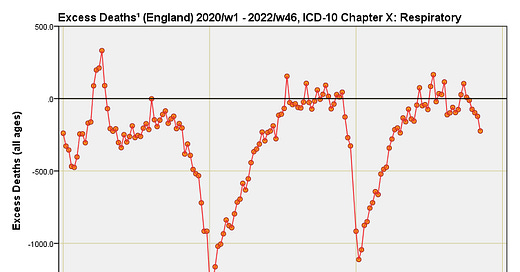Excess Deaths by Cause, England 2020/w1 – 2022/w46 (part 3)
Statistical analysis of a dataset obtained under FOI by Joel Smalley. In this article I present excess deaths for ICD-10 chapter X (J00 – J99): diseases of the respiratory system.
Please see part 1 of this series for background detail.
We now come the third most frequent cause of death, this being diseases of the respiratory system. This ICD-10 chapter covers everything from J00X Acute nasopharyngitis [common cold] to J99.8 Respiratory disorders in other diseases classified elsewhere. In plain English we’re talking asthma, COPD, emphysema, influenza, pneumonia, laryngitis, tonsillitis, bronchitis and, of course, my favourite coding: J67.2 Bird fancier’s lung.
More Deaths To Come
When viewing these slides please do bear in mind that delays in processing (largely due to involvement of the coroner) mean counts as far back as January 2022 are likely to be underreported, especially for the younger age groups. Because of the volume of slides I need to present and limits to email delivery I will keep commenting to a minimum.
Keep an eye out for the mysterious death spike of 2020/w15 (w/e 10 April) and a tailing-off of excess during 2022 for the younger age groups. Under ‘normal’ circumstances excess respiratory death should show as a series of waves flipping from positive excess to negative excess to positive excess. Keep your eyes peeled for any persistent trends or offsets, whether this is characterised by a persistent positive or negative excess. Please do remember that vaccine harm will be one of many factors.
One last thing… if you are expecting a surge in respiratory death due to COVID then think again! These respiratory deaths are strictly non-COVID, for COVID-related deaths were counted under ICD-10 Chapter XXII: Codes for special purposes.
Let’s tuck straight in…



